|
==============================================================================
TOPIC: YMCA Carolina Hemlock Bluffs
http://groups.google.com/group/entstrees/browse_thread/thread/56abdd5bd53a69a3?hl=en
==============================================================================
== 1 of 6 ==
Date: Thurs, May 8 2008 1:26 pm
From: "Josh Kelly"
*Report of the Carolina Hemlock Bluff Treatment at the YMCA Blue
Ridge
Assembly*
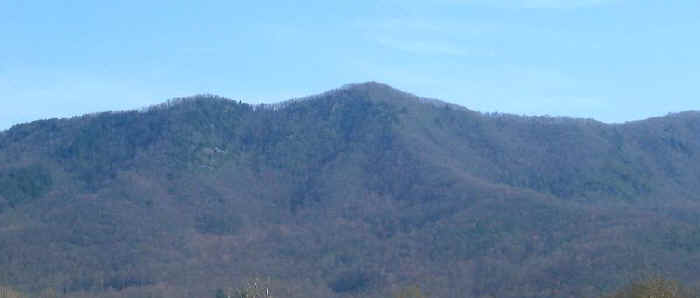
In 2007 I was alerted to the presence of a regionally and, perhaps,
globally
significant cluster of Carolina Hemlock Bluffs on the property of
the YMCA
Blue Ridge Assembly in Black Mountain, NC by Will Blozan of
Appalachian
Arborists and the Eastern Native Tree Society. Later that year I
also
learned of the efforts of Quality Forward to treat significant
hemlock trees
in Buncombe County. I contacted Bill Hascher, the director of
Quality
Forward's Treasured Trees program in late 2007 about treating the
surviving
old-growth groves in Western North Carolina. By early 2008 we had
developed
a plan of action that included treating the hemlock bluffs on the
property
of the Blue Ridge Assembly. After meeting with the director to the
Blue
Ridge Assembly, Kurt Eckel, and the head grounds keeper, Ed Colley,
we got
the approval and full support of the Assembly staff to go ahead with
the
treatment.
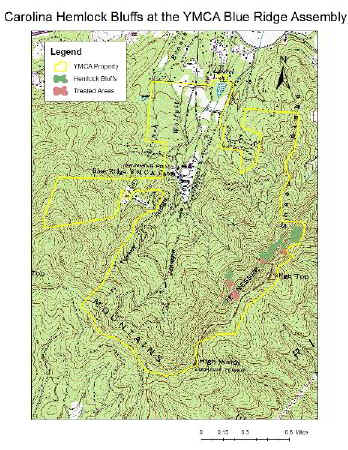 |
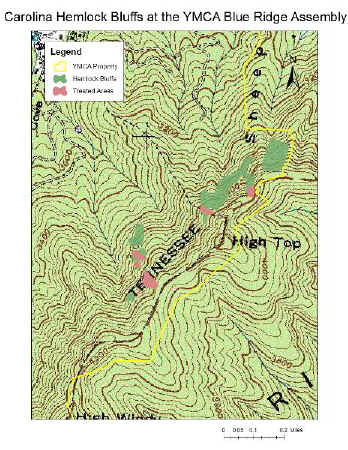 |
The Blue Ridge Assembly property is significant for its human and
natural
history. In this report, I will focus on the natural history of the
property. There are at least six forest types present on the
property and
two distinct cliff communities on the 1200 acre property. The forest
communities include High Elevation Red Oak forest on the highest
ridges,
Montane Oak-Hickory forest on ridges and slopes, Pine-Oak/Heath in
the
steepest areas with fire influence, Acidic Cove forests in the lower
coves
and along the streams, high quality Rich Cove Forest with a well
developed
herbaceous understory, and approximately 12-15 acres of Carolina
Hemlock
Bluff forest. Some of the oak hickory and Pine-Oak/Heath forests on
the
ridges and steep slopes appear to be primary. A pitch pine in
Pine-Oak/Heath proved to be 246 years old when cored. Even the Rich
Cove
Forests are amazingly mature with many remnant buckeyes and
basswoods and
northern red oaks exceeding four feet in diameter. How this property
did not
make it into the North Carolina Natural Heritage Program inventory
of
Buncombe County is a mystery to me.
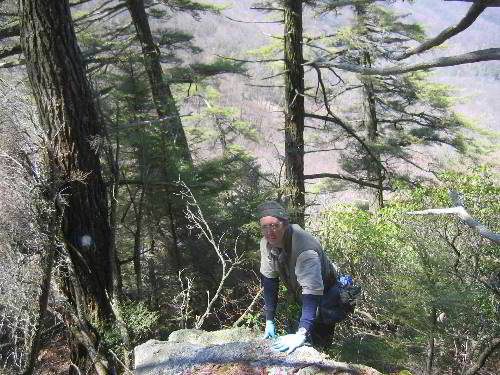 Rock Climb
Rock Climb
On April 3rd Kim and David Thompson joined Bill Hascher and myself
at the
Blue Ridge Assembly. Ed Colley was waiting there to meet us, and
used a
tractor and the Blue Ridge Assembly trail system to haul water up to
the
ridge 1500 feet above the parking lot. Without the support of Ed and
the
Blue Ridge Assembly, this effort would have been impossible because
of the
difficulty of hauling water up to the ridge. Kim, David, Bill and I
hiked
to the top of the mountain to meet Ed. We spent that first day
treating
trees in 50 degree drizzling rain. It was no picnic, and the efforts
of
Kim, David and Bill can not be overestimated. Kim and David put in
over 10
hours of hard work on the 3rd, and Bill worked for two days to make
it all
happen. That first day we treated over 1000 diameter inches of
Carolina
hemlock and set our priorities for work on April 7th and 8th. Our
work
focused on a grove near 4000' elevation between High Top and High
Windy and
some of the trees along the High Top trail that are visible to the
public.
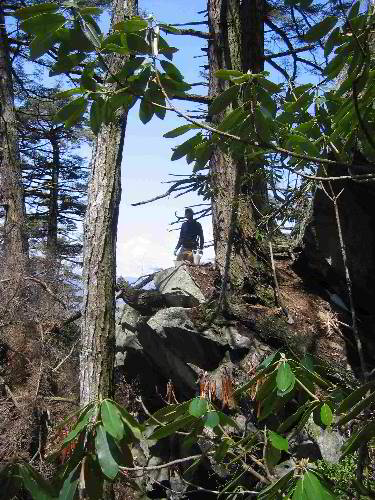 Spine
Spine
Bill and I returned on April 7th to treat some of the largest and
most
remote groves of our expedition. We treated Carolina hemlocks on
spines of
rock that fell precipitously on either side and included large,
gnarled
trees. An isolated hemlock in a protected cove had a diameter of 40
inches.
The hemlocks lower on the mountain were in worse health than those
higher
up. After the first day's monumental effort we decided that 7 hours
of hard
work was enough and called it quits.
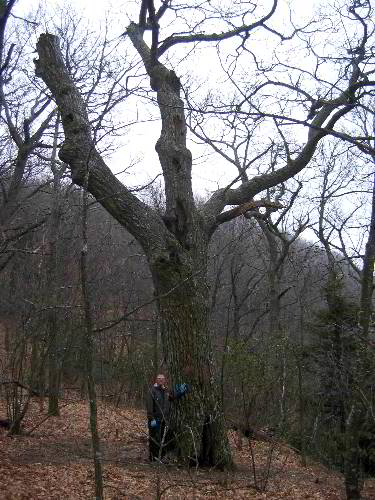 Veteran Red Oak
Veteran Red Oak
On April 8th I returned to complete the treatment. On the seventh I
noticed
a prominent ridgeline grove east of High Top. This grove is the most
visible one on the ridge from the Swannanoa Valley. I therefore made
the
effort to hike three gallons of water, chemical and the soil
injector out to
this grove. This final grove is easy to locate from the High Top
Trail. It
is on the ridgeline due east of High Top on an old, un-maintained
path. The
Carolina Hemlock Bluff here is unique in that it has an open
understory and
is composed mostly of large trees over 16" in diameter. It is
on the edge
of an extensive cliff community dominated by Carolina Hemlock. It
was sad
to see such a great example of Carolina Hemlock Bluff that would be
so
difficult, expensive, and time consuming to treat. I do take solace
in
having treated some of the finest groves on the mountain, but there
is so
much more to do!
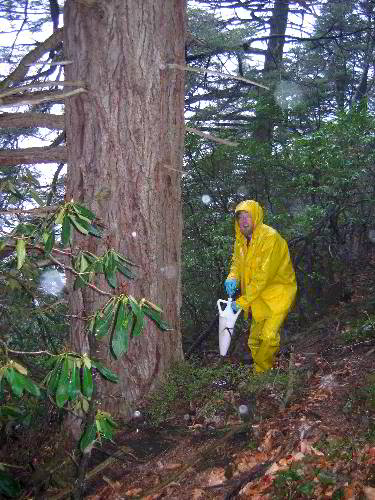 Wet Tree
Wet Tree
In all we treated approximately 2.3 acres of Carolina Hemlock Bluff
and
hundreds of trees ranging in size from 2" to 40" in
diameter. On
April 8thI was eating lunch on a rock outcrop on the High Top trail,
thankful for the
opportunity to be part of this worthy project, when a peregrine
falcon flew
by at eye level. My guess is that there is at least one nesting pair
of
this State Listed bird on the cliffs at the Blue Ridge Assembly.
This only
reinforced how special those hemlock bluffs are and how much they
deserved
to be saved.
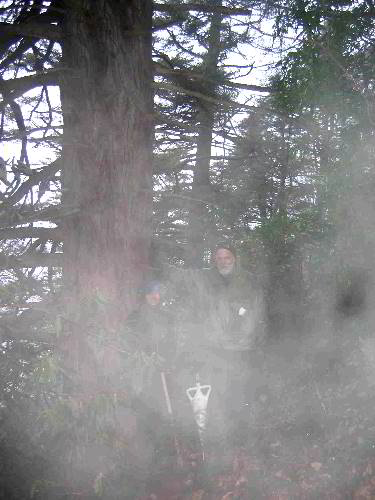 Kim and David
Kim and David
Special thanks to Robin Haynes and Quality Forward for funding this
project
and for the hard work of Bill Hascher, Kim Thompson and David
Thompson. Thanks
also to the YMCA Blue Ridge Assembly for being such good stewards of
this
important natural area over the years and to Kurt Eckel and Ed
Colley for
their support of this project. Finally, thanks to WildLaw for
supporting my
time and efforts to save remnant hemlock groves.
== 2 of 6 ==
Date: Thurs, May 8 2008 2:32 pm
From: ForestRuss@aol.com
Josh:
It was an exceptionally interesting, heartening and intriguing post!
Russ
== 3 of 6 ==
Date: Thurs, May 8 2008 4:32 pm
From: "Will Blozan"
Josh,
Excellent synopsis of the day and history! That very same day you
all
started I was treating another privately owned grove of old-growth
Carolina
hemlocks in Lake Lure. At least a few (Carolina Hemlock forests)
will survive.
Is the peregrine falcon rare enough to be the "spotted
owl" of the Carolina
hemlock forests? Perhaps funding for treating the grove (and others)
could
come from ornithological societies, Audubon, etc. Such conservation
would be
very good use of a reasonable amount of money and promote the plight
of the
forests as well. Just a thought which I am sure you are far ahead of
me on.
Will
== 4 of 6 ==
Date: Thurs, May 8 2008 6:03 pm
From: Josh
Will and Russ,
Thanks for the encouragement! Will, I'm so grateful that you've
taken
such a lead in all of this and been such a resource. I forgot to
mention in the trip report that Will was instrumental in getting a
wholesale price for imidacloprid.
As for the peregrine falcon: it was delisted by the Feds several
years
ago and may not be dependent on Carolina hemlock bluffs. It remains
a
threatened bird according to the NC Natural Heritage Program and is
just another compelling reason to save as much hemlock forest and
hemlock bluff as we can. Also of biological note, I found a
population of Salix occidentalis on High Top. This shrub is
apparently rather uncommon in NC.
Josh
== 5 of 6 ==
Date: Thurs, May 8 2008 6:07 pm
From: "Will Blozan"
Josh,
Still, a campaign geared towards the bird could generate the few
thousand
dollars needed to preserve the grove. If a viable nest could be
found
perhaps that would be reason enough.
Sounds like rappelling! Count me in!
Will
==============================================================================
TOPIC: YMCA Carolina Hemlock Bluffs
http://groups.google.com/group/entstrees/browse_thread/thread/56abdd5bd53a69a3?hl=en
==============================================================================
== 1 of 1 ==
Date: Fri, May 9 2008 6:03 am
From: Josh
Will, ENTS,
An issue that is heating up right now is whether or not Carolina
hemlock deserves Federal listing. Unlike the eastern hemlock, it
will
not be spared in any of its native habitat by cold winters, and will
definitely be reduced to a few small threads of its already small
(relatively) population.
I think a campaign to list the Carolina hemlock has real potential.
Listed plants carry almost no regulatory burden on private land, and
because of where Carolina hemlock grows, there is not likely to be
much conflict with developement anyway. The value of listing is that
it would bring much more money into the effort to treat and save
hemlocks, and many more groves of Carolina hemlock could recieve
chemical treatment. Any biological break-throughs that occured
because of increased research would also benefit eastern hemlock.
I know that ENTS does not engage in political efforts as an
organization, however, I think that we as individuals could do a lot
to stir up support for listing the Carolina hemlock. I'm going to
call Rep. Shuler today and try to get his office to start bugging
the
FWS. Maybe by early next year the FWS would have the latitude to
start listing species again after a new administration gets in the
White House.
I think the Carolina hemlock could be its own spotted owl!
Josh
==============================================================================
TOPIC: Federal Listing for Carolina Hemlock?
http://groups.google.com/group/entstrees/browse_thread/thread/6428ff88a11047ed?hl=en
==============================================================================
== 1 of 7 ==
Date: Mon, May 12 2008 9:57 am
From: Josh
ENTS,
In a recent post about treating Carolina hemlock our president, Will
Blozan, asked if peregrine falcon or some other cliff dwelling
species
might be the equivalent of the spotted owl for that species. In a
couple of different replies to that post, I pondered that question
and
my best answer was that Carolina hemlock is its own spotted owl. I'm
not sure if folks noticed that part of the thread, so I started a
new
post.
Basically, I think it could be incredibly beneficial if the Carolina
hemlock (Tsuga caroliniana) was given some sort of status that would
increase funding for combating hemlock wooly adelgid. Already,
Carolina hemlock is a Federal Species of Concern (FSC). This has not
been enough to protect this important and unique hemlocks. Carolina
hemlock, unlike eastern hemlock (Tsuga canadensis) will never be
safe
in even a portion of its range because of cold winter temperatures.
This is a plant that will be EXTINCT in the next 5-10 years without
continued human intervention. I think it would be wonderful for all
of us, as individuals, to lobby our elected officials to support
listing the Carolina hemlock as Federally Threatened (T). In the
case
of Carolina hemlock, this listing would not be needed to protect
habitat - its cliff habitats are relatively secure. Listing could
attract much needed funding for chemically treating Carolina hemlock
bluff communities and for increased funding for biological control
of
HWA.
I would love to hear others' thoughts on this strategy.
Josh Kelly
== 2 of 7 ==
Date: Mon, May 12 2008 10:11 am
From: James Parton
Josh,
Agreed! Carolina Hemlock should be considered an endangered species,
even more than the Eastern Hemlock. How could ENTS as a whole lobby
for this tree to become so? We have never been an activist group but
this would be a good cause for us to put our best foot forward.
James Parton.
== 3 of 7 ==
Date: Mon, May 12 2008 11:08 am
From:
You don't really lobby for ESA threatened or endangered status. You
petition the FWS with detailed documentation. See the documents on
the U.S. Fish and Wildlife Service's ESA Listing web site:
http://www.fws.gov/endangered/listing/index.html
PJ
== 4 of 7 ==
Date: Mon, May 12 2008 12:06 pm
From: Josh
Thanks Paul!
The official process is a petition. However, in the
hyper-politicized
realm of conservation, the support of local representatives and the
executive branch (wait a few months) sure help. Don't hesitate to
call your Reps and Senators voicing support for listing the Carolina
hemlock.
Josh
== 5 of 7 ==
Date: Mon, May 12 2008 1:21 pm
From: Andrew Joslin
I looked at the petition process flow chart and it looks like a
minimum 1 year 4 months (if I counted correctly) from initial
petition to granted status. I'm guessing that once status is granted
it's like starting from zero as far as getting an action plan and
money approved. Given the rapid progression of HWA can the listing
process and resulting action occur quickly enough to be effective?
It
might be useful to cultivate lines of communication or contacts
within the listing program to determine if an expedited listing
process can be implemented for Carolina Hemlock.
-AJ
Andrew Joslin
Jamaica Plain, MA
== 6 of 7 ==
Date: Mon, May 12 2008 12:37 pm
From: Mollie Matteson
Folks, I have not been following this thread very closely, so
forgive
my jumping in mid-discussion. If there's an interest and concern
about getting this species listed, I'd suggest talking with a couple
folks at the Center for Biological Diversity--Emily Roberson and
Noah
Greenwald. CBD has a great deal of expertise in the petitioning
process (I am also a CBD staffer, but am a relative newbie as far as
petitioning goes). There is a provision in the ESA for emergency
listing, but I don't know much about how it works.
Contact info for Emily and Noah can be found at the Center's
website:
http://biologicaldiversity.org
Mollie Matteson
~~~~~~
PO Box 551
37 Hapgood Lane
Richmond, VT 05477
802-434-5212 (home)
802-434-2388 (work)
802-318-1487 (cell)
"As human beings, our biggest asset is love, so now is the time
to
get up off our big fat assets, and practice supply-side
spirituality.
Because we aren't here to earn God's love, we are here to spend it.
"
~~Swami Beyondananda, aka Steve Bhaerman
== 7 of 7 ==
Date: Mon, May 12 2008 5:56 pm
From: DON BERTOLETTE
ENTS-
It's worth it, but you need to know that this is a long drawn out
process that will guaranteed tax your patience...and it's absolutely
essential that you establish good rapport with FWS, right from the
start. Be charming!
-DonRB
|